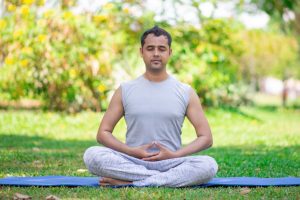In a world where the demands of modern life often lead to stress and pollution, maintaining respiratory health has become increasingly important. Yoga, an ancient practice that intertwines physical postures, breathwork, and mindfulness, offers a holistic approach to fostering lung health. In this article, we will delve into five yoga asanas specifically designed to promote healthy lungs, enhance respiratory function, and create a deeper connection between the body and breath.
Anulom Vilom (Alternate Nostril Breathing):
Anulom Vilom, also known as Nadi Shodhana or alternate nostril breathing, is a powerful pranayama technique that helps balance the two hemispheres of the brain, calm the nervous system, and enhance lung capacity. This practice involves controlled breathing through alternate nostrils, promoting optimal oxygen exchange and detoxification.

How to practice Anulom Vilom:
Sit comfortably in a cross-legged position, keeping your spine straight.
Close your eyes and bring your right hand to your face, with the index and middle fingers resting between your eyebrows.
Close your right nostril with your right thumb and inhale deeply through your left nostril.
Close your left nostril with your ring finger, release the right nostril, and exhale slowly and completely.
Inhale deeply through the right nostril, close it with your thumb, release the left nostril, and exhale.
Repeat this cycle for 5-10 minutes, gradually increasing the duration as you become more comfortable.
Practicing Anulom Vilom regularly enhances respiratory efficiency, reduces stress, and improves overall lung function.
Bhujangasana (Cobra Pose):
Bhujangasana, or Cobra Pose, is a backbend that not only strengthens the spine but also expands the chest, encouraging deep breathing and increased lung capacity. This pose opens up the chest and stretches the front of the body, facilitating improved airflow into the lungs.
How to practice Bhujangasana:
Lie on your stomach with your legs extended and palms placed beside your chest.
Inhale, press your palms into the mat, and lift your chest off the ground, keeping your lower body grounded.
Elongate your neck and gaze forward, maintaining a gentle curve in your spine.
Hold the pose for 15-30 seconds, breathing deeply and feeling the expansion in your chest.
Exhale and slowly lower your chest back to the mat.
Regular practice of Bhujangasana not only promotes lung health but also strengthens the back muscles and improves posture.
Kapalbhati Pranayama (Skull Shining Breath):
Kapalbhati, a dynamic and energizing pranayama technique, is known as the Skull Shining Breath due to its cleansing effect on the lungs and respiratory system. This rapid and forceful breathwork helps remove toxins, increase lung capacity, and enhance oxygen absorption.
How to practice Kapalbhati Pranayama:
Sit comfortably with your spine straight and shoulders relaxed.
Take a deep breath in, expanding your lungs fully.
Exhale forcefully through your nose, drawing your navel toward your spine.
Allow the inhalation to happen naturally as your abdomen expands.
Repeat this cycle for 1-2 minutes, gradually increasing the duration as your endurance builds.
Kapalbhati not only boosts lung health but also invigorates the entire respiratory system, promoting mental clarity and vitality.
Ustrasana (Camel Pose):
Ustrasana, or Camel Pose, is a heart-opening asana that stretches the chest, lungs, and abdomen. By encouraging deep breathing and expanding the chest, Ustrasana helps increase lung capacity and alleviate respiratory issues. This pose also improves posture and flexibility in the spine.
How to practice Ustrasana:
Kneel on the mat with your knees hip-width apart.
Place your hands on your lower back, fingers pointing downward.
Inhale, engage your core, and lean back, arching your spine and reaching for your heels with your hands.
Hold the pose for 15-30 seconds, breathing deeply and lifting your chest toward the ceiling.
Exhale and return to the starting position.
Regular practice of Ustrasana promotes lung health, stimulates the respiratory system, and enhances overall flexibility.
Dirga Pranayama (Three-Part Breath):
Dirga Pranayama, or the Three-Part Breath, is a calming and grounding breathing exercise that promotes lung expansion, diaphragmatic breathing, and mindfulness. By consciously engaging the three parts of the lungs—lower, middle, and upper—this pranayama technique enhances respiratory efficiency and fosters a sense of relaxation.

How to practice Dirga Pranayama:
Sit comfortably with your spine straight and shoulders relaxed.
Place one hand on your chest and the other on your abdomen.
Inhale deeply through your nose, allowing your abdomen to expand first, followed by the middle and upper chest.
Exhale slowly through your nose, reversing the process by emptying the upper chest, middle chest, and finally the abdomen.
Repeat this cycle for 5-10 minutes, focusing on the smooth and controlled flow of breath.
Dirga Pranayama not only improves lung capacity but also promotes relaxation, reduces stress, and enhances overall respiratory well-being.
Conclusion:
Incorporating these five yoga asanas into your regular practice can be a transformative journey toward healthier lungs and improved respiratory function. As you embrace breath through pranayama techniques and purposeful movement, you not only enhance the physical capacity of your lungs but also cultivate a deeper connection between your body, mind, and breath.
Remember to approach your yoga practice with patience and mindfulness. Consistency is key, and gradual progress will lead to lasting benefits. Whether you are a seasoned yogi or a beginner, these asanas offer a holistic approach to lung health, promoting overall well-being and vitality. By prioritizing your respiratory health, you embark on a path that nurtures both the physical and spiritual aspects of your being.
